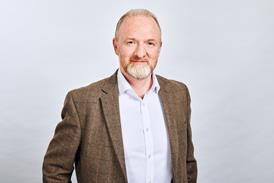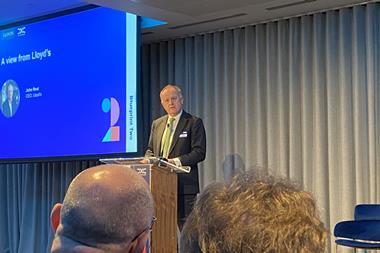With the onset of the Covid-19 pandemic sharpening Lloyd’s of London’s focus on its Blueprints, Insurance Times takes a deeper dive into what’s behind Blueprint Two
Blueprint Two is Lloyd’s of London’s “when rubber hits the road moment,” according to chief executive John Neal.
By this Neal means: “This is the time when arguably the hard work really starts but also where great progress can and will be made. It is going to take the whole market to support us if we are to succeed.”
Lloyd’s will be redesigning its entire insurance lifecycle in the latest blueprint which will run for two years, and target £800m of savings for market participants, being funded by debt raised in early 2020.

Deeming the latest Blueprint Two “quite revolutionary,” Neal hopes that the London Market will be better connected, faster and be able to remove significant frictional cost from its processes.
But how might Blueprint Two’s proposal change things for the better? And how does this differ from Blueprint One?
It follows Blueprint One being launched fourteen months ago.
Moment of truth
Siding with Neal, Guidewire’s Ian Gibbard, senior sales and account executive told Insurance Times: “All-in-all Blueprint Two is a great ambition, to make London a great place to buy insurance.
“My words of caution and encouragement come from the experience of the greater insurance and technology world.
”It needs openness and the willingness to compromise. Don’t lose what could be good by waiting for the best. That will never materialise, and you could end up with the worst.”
Gibbard has over 30 years of experience across the London Market, he began his career as a trainee underwriter at Lloyd’s.
“The problem that the London Market has is that its systems have been around for 30 or 40 years, they have been implemented for the requirements of that market and that means there’s no path forward to upgrade the software,” Gibbard said.

Meanwhile, Blueprint Two describes claims as the “moment of truth” for its customers, with straightforward claims being resolved automatically, he pointed out.
“It’s a great ambition and although the processes and systems in use now are a world away from being able to support it, he continued.
”It can be achieved if Lloyd’s is willing to be pragmatic rather than dogmatic, and most importantly is prepared to be transparent and allow it and the market players – syndicates, businesses and brokers to be equally accountable to customer and public scrutiny.”
For Gibbard, transparency at individual account or claim level means that customers can always see where a claim is and how it is fairing against service level agreements (SLAs).
He continued: “At an organisational level the performance of brokers and carriers in the market should be available for all to see on-line.
”I don’t see anything in the Blueprint designed to allow publicly scrutiny and measurement of performance and that is a mistake. There is nothing like public embarrassment to encourage compliance.”
Changing direction
Blueprint Two is about “implementation and delivery” signalling a change in approach according to Oxbow Partners’, senior consultant Lucy Alphonse.
It focuses on the two most common Lloyd’s customer journeys – open market and delegated authority, but reinsurance and automated placement have been put on the backburner.
In Blueprint One, Lloyd’s previously said it would control the end-to-end market technology for risk placement. But Ben Potts, Novidea’s managing director said that it was great to see in the current Blueprint that “Lloyd’s has changed direction”. For example, by embracing the value external vendors can bring to the market.
This opens tremendous opportunities, according to Potts for firms like Novidea to integrate data-first an Application Programming Interface (API) – where multiple back-end software can communicate, enabling solutions with the London market ecosystem.
Blueprint Two initiatives
1. Open market -getting covered initiatives: It outlines several open market placemet initaives shifting the focus away from owning a single placement platform (PPL) to settiing stadards for othe rmarket participants and vendors.
2. Delegated authority - ’getting covered’ initiatives: An end-to-end platform to digitise processing and provide tools to coverholders
3. Open market -’recovering from loss’ initiatives: It will introduce a new claims platform and ultimately replace ECF and CLASS.
4. Delegated authority-’recovering from loss’ initiatives: Lloyd’s are not creating a new process for delegated authority claims and will work largely with the existing model where the majority of claims are handled by Delegated Claims Administers (DCAs).
5. Digital processing initiatives: It will implement a Digital Gateway to validate, enrich, route, store and report data from placement to processing.
How has Blueprint One’s solutions been affected?
Blueprint One’s six solutions have been subsumed in the new structure, these include:
- Complex Risk Platform: Lloyd’s will no longer develop its own placement platform, instead it will provide risk placement standards (data and processes) and focus on the next generation of PPL.
- Lloyd’s Risk Exchange: There have been some experiments using algorithms to underwrite business automatically, and this will form the basis of further research and experimentation over the next year.
- Claims Solution: Claims continue to be a significant part of the Future at Lloyd’s, and Blueprint Two has built on the triaging, automated decision-making, and orchestration of complex claims handling outlined in Blueprint One.
- Capital Solution: Blueprint One outlined a plan for simpler capital rules, new and complementary structured investment opportunities, and a central capital platform. In light of market feedback and the pandemic this work has been paused. A platform giving market participants easy access to Funds at Lloyd’s data was developed, it went live in October 2020.
- Syndicate in a Box (SIAB): Four SIABs have been launched so far with ten proposals in the pipeline. The initial approach to reviewing and approving applications has been revised to be more efficient. Immediate plans include fine tuning the criteria, making explanation and information more widely available, and working with managing agents to increase capacity to manage SIABs.
- Services Hub: The concept of providing new and innovative services to market participants has been integrated into the new approach.
Source: Oxbow Partners
‘Validation and verification’

Blueprint Two repeatedly references “validation and verification” of claims against policy information collected during placing.
And Gibbard warned that “creating dependency could very well compromise the excellent service that Lloyd’s intends” for its customers, referencing nearly 300 claims platforms implementations at Guidewire.
“A pragmatic approach will ensure that claims can still be notified and processed to service level agreements even with incomplete or missing policy data,” he advised.
Meanwhile using artificial intelligence or predictive analytics instead of hard-wired rules, could make the routing of claims to the correct workflow or lead carriers more effective.
“With such a large record of claims outcomes at hand the market is uniquely able to use data to its advantage, integrated into the triage and workflow processes,” he said.
Although Gibbard admitted that market agreements on data ownership might need to change.
Unforeseen eventualities
Gibbard stressed the importance of using a resilient platform for the market, that is scalable based on the “fluctuations of real-time demand and unforeseen eventualities”.
“Current market systems have a tendency to be less than ideally robust and not able to scale for short notice increases in demand,” he said.
He gave the Electronic Claims File (ECF) platform as an example, with carriers facing ”real problems” in being able to implement the write-back integration to move data from a cloud application to an on-premises database because of poor uptimes (a measure of system reliability typically the time a computer has been up or available) and performance.

Cloud native
Gibbard said: “The market needs to take a hard look at who supports its systems and be prepared to pay for the best, if that’s what it wants to deliver to its customers.”
He recommended that any modern platform should be provided as native cloud solution for the purpose of the top security, support, scalability as well as integration to an insurtech ecosystem.
“Ideally, the platform should never need to be upgraded, but instead updates should be continuously applied by the supplier or vendor, ensuring that the technical debt incurred through older and older operating systems and database is a thing of the past,” Gibbard added.
Speaking of digital ecosystems, Potts said: “This will bring huge benefits to the market, as it will not be so held back by legacy systems and can work with ‘best of breed’ suppliers.
“It also means that Lloyd’s can focus on setting the standards and we can all start moving towards being a truly data-first marketplace, where all parties can work together more seamlessly and efficiently, to the benefit of all parties.”
Hosted by comedian and actor Tom Allen, 34 Gold, 23 Silver and 22 Bronze awards were handed out across an amazing 34 categories recognising brilliance and innovation right across the breadth of UK general insurance.




















































No comments yet